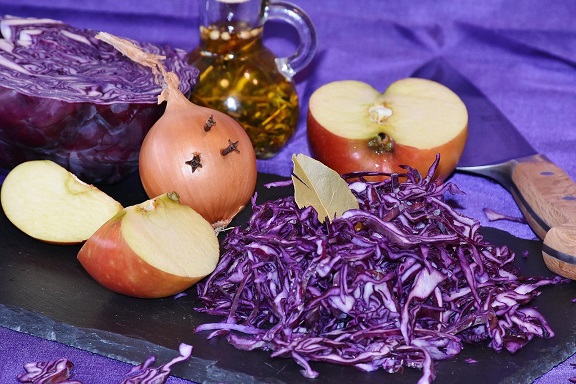
Rotkohl is Germany’s iconic red cabbage dish, a comforting balance of sweetness, tang, and spice. Slow-cooked with apples, onions, vinegar, and cloves, it’s the traditional side for Easter roasts, pork, or duck, and pairs beautifully with potato dumplings or mashed potatoes.
This vibrant dish is not only flavorful—it’s colorful and festive, adding visual warmth to any spring table. It’s also a great make-ahead dish that tastes even better the next day.
History & Cultural Significance
Rotkohl has been part of German home cooking for centuries. In most regions, it’s considered an essential side dish for roast meats, especially during holidays. The red cabbage is sliced thin and gently simmered in a sweet-sour base until tender, often with apples or red currant jelly for depth.
In southern Germany, the dish may be called Blaukraut and seasoned with more vinegar for a slightly tangier taste. During Easter, Rotkohl balances the richness of main dishes like Osterbraten or Easter ham, making it a beloved tradition.
Want more German Salad Recipes? See Kartoffelsalat or Frühlingsgemüse.
Ingredients & Preparation
Ingredients
- 1 small red cabbage (about 800g), finely sliced
- 1 onion, thinly sliced
- 1 apple, grated or finely chopped
- 2 tbsp butter or goose fat
- 3 tbsp apple cider vinegar
- 100ml (½ cup) apple juice or red wine
- 1–2 tbsp sugar (to taste)
- 2 cloves
- 1 bay leaf
- Salt and pepper, to taste
- Optional: 1 tbsp red currant jelly or cranberry sauce
How to Make Rotkohl
Melt butter in a large pot over medium heat. Add sliced onion and apple, sauté for 3–4 minutes.
Stir in sliced cabbage and cook for another 5 minutes until slightly wilted.
Add vinegar, apple juice, sugar, cloves, bay leaf, salt, and pepper. Cover and simmer gently for 45–60 minutes, stirring occasionally.
Remove cloves and bay leaf before serving. Adjust seasoning and add jelly if desired for sweetness and shine.
Serving Suggestions & Variations
How to Serve
Rotkohl is best served warm with:
- Osterlammbraten or Osterbraten
- Potato dumplings or mashed potatoes
- Roasted duck or goose
- Easter ham with mustard glaze
Variations
In Bavaria, more vinegar and less sugar create a sharper version. In Rhineland, it’s sweetened with applesauce or red currant jelly. Some versions add cinnamon or caraway for extra flavor.
Looking for a full Easter spread? Try it with Hase in Rotweinsauce or Spargelsalat.
Rotkohl is a side dish that tastes like home—tender red cabbage, balanced with sweet and sour notes, and gently spiced. Whether served at Easter, Christmas, or a family dinner, it’s a perfect companion to Germany’s most beloved main dishes.
Complete your meal with other German classics like Kartoffelsalat, Frühlingsgemüse, and Osterbrot.
